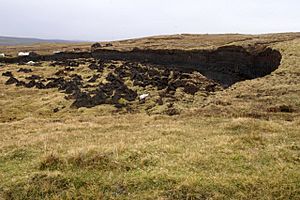Blanket bog facts for kids
Blanket bogs are special types of wetlands. They are areas covered by a thick layer of peat. Peat is made from dead plants that don't fully rot because of the wet and cool conditions. These bogs get their name because they form like a "blanket" over large areas of land. This happens even on hillsides, not just in flat, wet spots.
They form in places with lots of rain and not much evaporation. This allows the peat to build up over time.
Where in the World Are They Found?
Blanket bogs are very common in the northern parts of the world. You can find many well-known examples in Ireland and Great Britain. Huge areas of the Russian and North American tundra are also blanket bogs. The most southern blanket bogs in Europe are in the Cantabrian Mountains in northern Spain.
In the Southern Hemisphere, blanket bogs are not as common. This is because the main land areas are closer to the equator. However, similar environments exist in places like Patagonia, the Falkland Islands, and New Zealand.
On subantarctic Macquarie Island, some blanket bogs are called 'featherbeds'. They can be up to 5 meters (about 16 feet) deep! These featherbeds can shake or quake when you walk on them, making them tricky to cross.
Scientists think that in some parts of Europe, blanket bogs grew larger because ancient people cut down forests.
Why Are Blanket Bogs Important?
Blanket bogs are very important for many reasons:
- Home for Wildlife: They provide a unique home for special plants and animals. Many rare birds, insects, and plants live only in these bog environments.
- Storing Carbon: Bogs store a lot of carbon in their peat. This helps to control the amount of carbon dioxide in the air, which is good for our planet's climate.
- Water Filters: They act like giant sponges, soaking up rainwater. This helps to prevent floods and slowly releases clean water into rivers and streams.
Peat Harvesting and Protection
For a long time, people have used peat as a fossil fuel. It can be burned to create electricity or used as fuel for heating homes. In the Republic of Ireland, a company called Bord na Móna used to harvest large amounts of peat for power plants. However, many of these peat-burning power stations have now closed down. Some areas where peat was harvested are now used for wind farms.
Today, many blanket bogs are protected by governments and environmental groups. This is because these special habitats are in danger from too much peat harvesting. Protecting them helps to save their unique wildlife and keeps them working as natural carbon stores and water filters. Examples of protected blanket bogs include Sliabh Beagh and Airds Moss.


